How to use AR in marketing to build a positive brand experience
app developmentartificial intelligenceaugmented realitycloud computingtechnologyTechnology is constantly evolving, and many of its developments, such as VR and AR, continue winning new users across industries. Although augmented reality (AR) is still a novelty in 2020, its potential proves immense in the fields of healthcare, real estate, manufacturing, education, entertainment, and marketing. That said, AR is the technology that more and more brands are eager to acquire access to when developing their content marketing strategies. Marketing is driven by customer wants and needs and augmented reality is the innovation that can dramatically improve customer experience, making consumer connections more meaningful and emotional.
The common point of the reports on the current and future status of AR is that the technology will continue becoming more widespread and effective. So, why not delve into the subject while it is still something new and exciting? Thinking creatively and innovatively is the marketers’ key to success. Investing in AR is exactly what one should do today, and we will explain to you why!
In this article, we’re going to place a particular focus on AR usage within the context of marketing and advertising. Let’s find out what benefits you are to derive by implementing AR and how exactly you can incorporate it into your business.
What is augmented reality in marketing?
Augmented Reality (AR) is generally known as the enrichment of the objects and spaces in the physical world through the use of computer-generated artificial, virtual and synthetic 3D elements. AR seamlessly combines real and virtual, blending interactive digital content into a person’s view of the physical environment. It is interactive in real time and tied to specific locations or activities.
The AR technology is now more available to users than ever before due to the fact that processors in mobile devices, such as smartphones and tablets, are becoming more powerful, screen resolution is becoming higher, devices’ cameras are highly-developed and are empowered with features like GPS, digital compasses and accelerometers. It is becoming so powerful that we cannot but look forward to a new user experience design era.
User experience is a holistic concept. It encompasses all the ways in which people use an interactive product like a mobile app. In the case of augmented reality-powered applications, both utilitarian and emotional appraisals influence customers’ attitudes to the product or brand. It is equally important that users feel good about an AR-powered app while using it and that this AR experience can better serve their purposes and better fit into the entire context in which people are using the product.
High levels of augmentation quality, informativeness, interactivity, utility, as well as hedonic and aesthetic quality, are the most important product attributes that make a difference in the user experience of AR apps. And the longer technology is present on the market, the more advanced and capable of meeting those criteria it becomes.
The AR technology is promising, indeed. According to the Statista forecast, the number of mobile augmented reality (AR) users worldwide is anticipated to reach 2.4 billion by 2023.
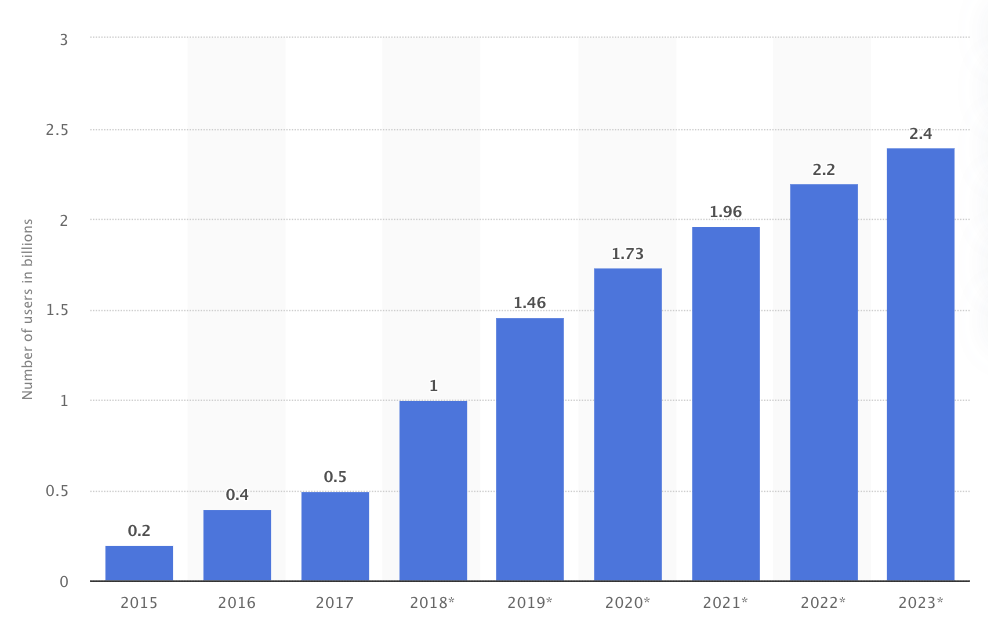
The forecast seems accurate, especially in the light of the Covid-19 pandemic. The IBM’s 2020 U.S. Retail Index report claims the pandemic has accelerated the shift to digital shopping by, at the very least, five years. At the same time, Shopify confirmed that interactions with products powered by 3D or AR content had displayed a 94% higher conversion rate than for products without those technologies.
Marketing is generally expected to be one of the most useful areas of AR’s application. It is mostly due to the fact that Augmented Reality Marketing focuses on creating digital affordances in a physical environment meant to assist customers’ actions and improve their experiences and decision-making. That said, the application of digital marketing technologies via the AR marketing interface looks like an absolute win-win. And we are about to go into more detail about why it is so. But first, let’s find out how AR works and how different AR vs. VR are.
What’s the difference between AR and VR?
Augmented and virtual reality fascinates businesses and broad audiences alike. Not everybody, however, knows exactly how these systems function and how significant the difference between these technologies is.
When comparing VR vs. AR, it is reasonable to say that the latter provides alphanumeric, symbolic, or graphical information based on real-time surroundings. In contrast, the former provides a complete replacement for an actual visual world.
Different from VR augmented reality does not replace the actual world. Instead, it enriches the environment with 3D digital elements, using computer vision, mapping, and depth tracking. These elements are aligned, correlated, and stabilized in a spatially contextual and intelligent manner. AR is now used in augmenting displays like those in smart glasses and handheld AR devices like tablets and smartphones. These devices use the onboard cameras to merge a real-world setting with a computer-generated 3D image.
In turn, virtual reality refers to display technologies – worn ones and fixed placements – that offer users a compelling visual sensation of presence or immersion withing a 3D computer simulation (a 3D model.) This experience is enabled by the use of stereoscopic head-mounted displays and semi-immersive projection-based systems like virtual domes. The VR visual display is normally supplemented by an audio solution. You can see how AR and VR work on the image below:
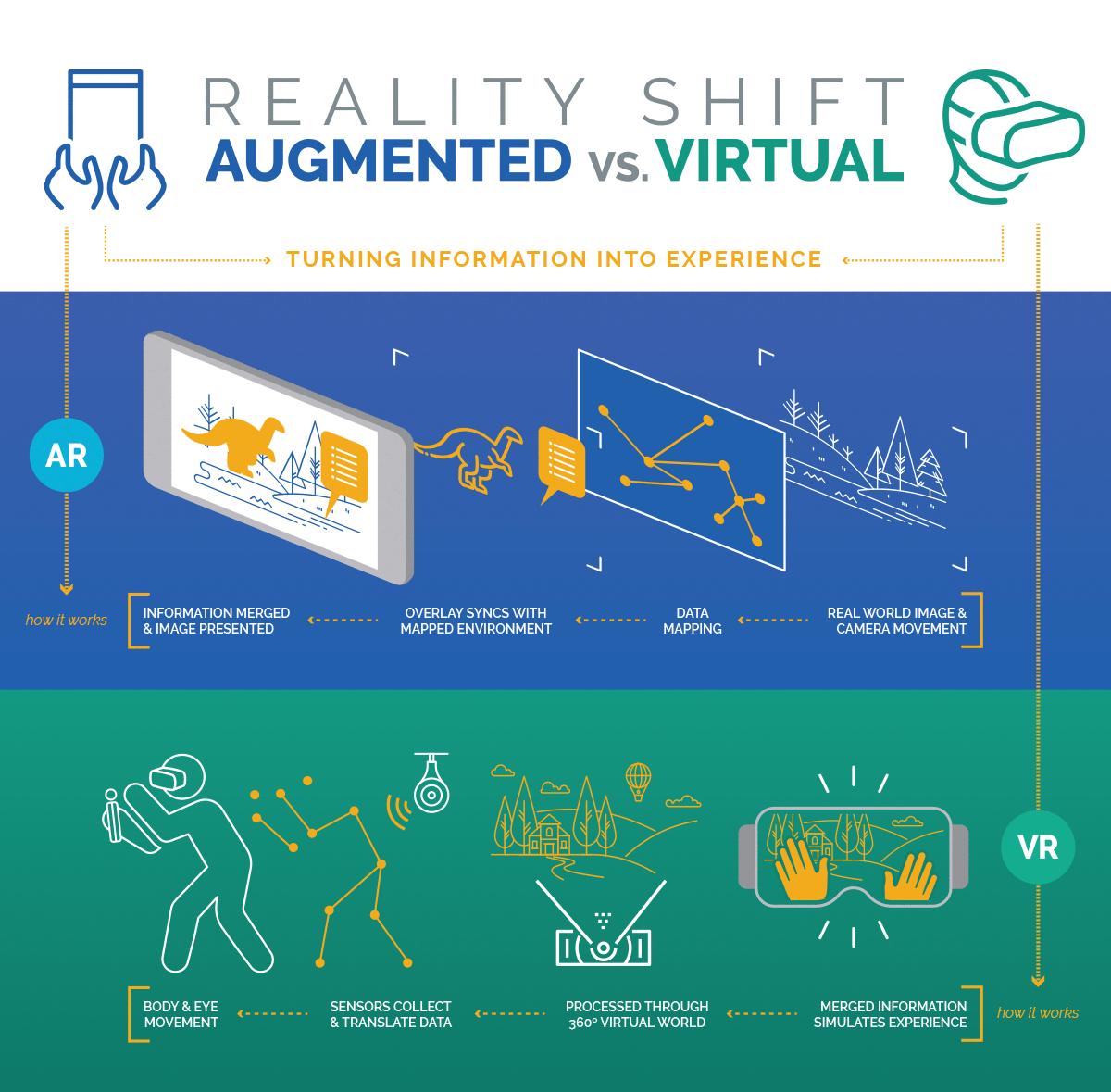
Just like Virtual Reality, AR technology keeps growing in popularity, though at different rates. Thus, according to eMarketer, the number of AR users is forecast to reach 95.1 million in the US, compared to 60.8 million that US VR users are expected to total within the same timeframe.
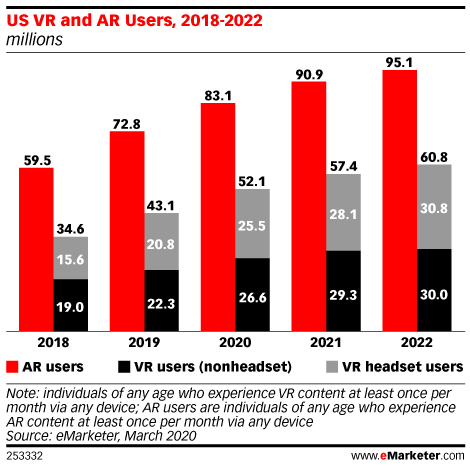
VR and AR are different. They have their pros and cons, potential and existing spheres of application, daunting challenges, and interesting use cases. However, they can work together. Their interoperability makes it possible to generate more engaging experiences and give a new dimension to interactions between the real and virtual worlds.
Types of augmented reality
Now that we’ve defined what augmented reality is and how different it is from virtual reality, let’s discuss briefly the four main types of AR that marketers can use in their digital marketing strategies: marker-based, markerless, superimposition-based, and projection-based.
1. Marker-based augmented reality. Marker-based AR technologies were invented prior to all other AR types and are currently used more rarely than, for example, markerless AR. They suggest that the system needs specific predefined detectable “markers” to indicate objects in a given setting. To understand what the user wants to focus on, the system needs a 2D picture, QR code, or 3D object that would function as a marker and identify the position of the virtual objects to be displayed. It is only upon detection of the specific markers that the app will showcase the AR-powered digital content.
2. Markerless augmented reality. This is the most popular image recognition method for AR applications nowadays. The difference between marker-based and markerless types is in the information source for identifying the digital content’s positioning within the user’s or camera’s view. Thus, in markerless AR, the user can place the virtual object anywhere within the given range using GPS and the compass sensor on the smartphone. For instance, this method was used in the infamous Pokémon Go game.
The technology keeps moving forward, so there are even platforms – ARKit for iOS and ARCore for Android – that simplify markerless AR app development. To ensure virtual objects remain accurately positioned in the real world, they use data from a device’s motion sensor and camera to identify spatial movement across six axes without any prior knowledge of the environment.
3. Superimposition-based AR. The primary objective of superimposition-based augmented reality is to partially or fully replace an object’s original view with a newly generated augmented view of that same object. This type of AR heavily relies on object recognition; otherwise, the application won’t be able to replace the original view with an augmented one. One of the examples of superimposition-based AR is a parking assist system in which AR recognizes the road boundaries to outline them for the driver. Also, other examples of this type of AR can be found in some furniture showrooms like IKEA.
4. Projection-based augmented reality. In the case of this AR type, artificial light is projected onto objects in the real-world scene. Projection-based AR is mostly used to analyze the object’s structure in more detail, examining its position, orientation, and depth. Normally, this type of AR is not used in mobile applications. The typical example of projection-based augmented reality is the hologram, where projection-based AR gets activated when the light is blown on the surface.
Advantages of using AR in marketing
As of today, there are many potential use cases for augmented reality. Marketing is the field where one will be able to find a perfect balance between informativeness and enjoyment created by means of augmented reality. Let’s now see what other advantages the use of AR in marketing can bring and what else you can do when adding AR to your mobile app!
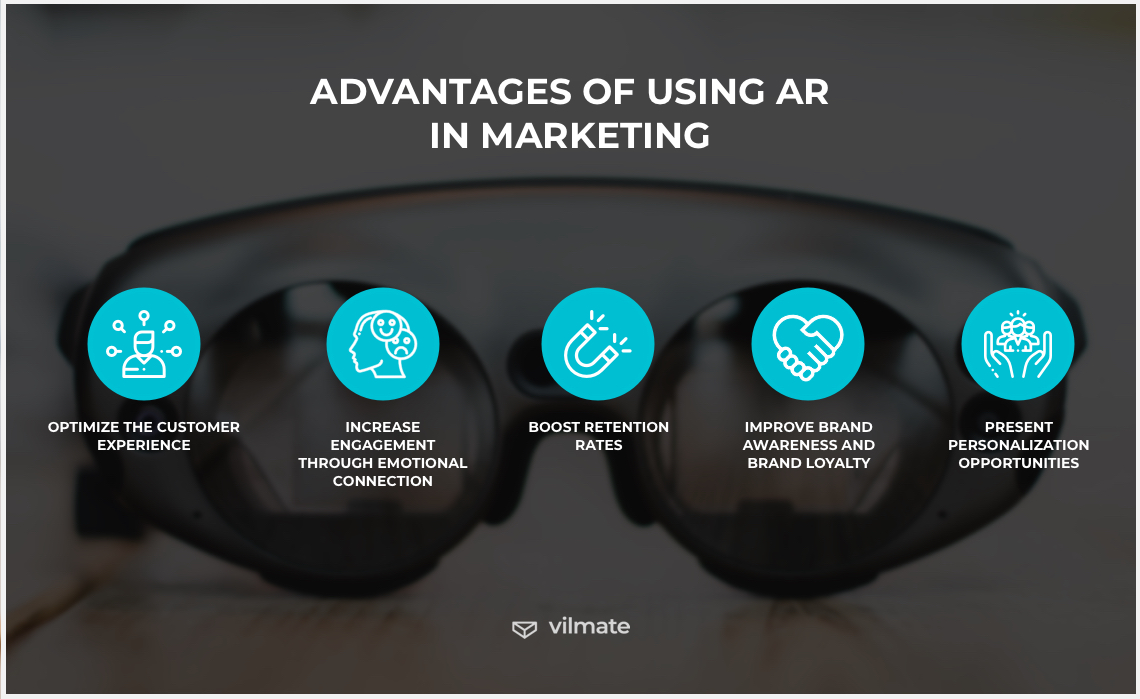
1. Optimize the customer experience
Not only AR embeds holograms of products and other virtual objects into the real scene, but it also uses contextual information about those products and the setting to assist customer actions and experiences. This all results in the overall customer experience optimization. And in particular, interactive experience proves more aesthetically pleasing and playful, the app itself becomes more useful and easy to use, and customer service excellence becomes more achievable.
AR technology enables interactivity and vividness of the experience. In turn, these two qualities are responsible for enhancing customers’ cognitive and affective evaluations of the marketed product that is viewed through the lens of AR. As a result, people tend to develop more positive attitudes towards and assessments of those products when the experience of interacting with them becomes more immersive, mediated by augmented reality.
This positive attitude highlights the functional benefits that augmented reality brings to the table. So, not only it becomes more enjoyable for a customer to complete certain tasks on your app using its AR feature, but it also enables them to make better purchase decisions.
2. Increase engagement through emotional connection
The adoption of AR can be considered successful if the technology, among others, makes it possible to understand the emotional context of the user’s experience. AR will then adapt according to what it has perceived and generate more stimulating and pleasant experiences for customers.
AR interactive technologies have the power to present more lively product visualizations to users, which makes it feasible to create more powerful emotional connections and positive affective experiences. Augmented reality marketing enables the exploration of products unrestrained by the reality of users’ actual environment. In addition to being more informative than 2D pictures, such experiences also enrich customers’ imagination, causing them to feel enjoyment and fun.
Not necessarily, it is the purchase that the user is prompted to make. Augmented reality can be used in marketing to emphasize your brand’s marketing message and engage users in whatever manner available, be it consuming more content on an app, sharing content on social media, or actually making a purchase. The fact that people feel more emotionally involved when there is AR enhancement in place results in an increase in the quality and the number of interactions. With higher engagement that is inherent in augmented reality marketing, brands will be reaching customers more effectively.
3. Boost retention rates
Augmented reality truly adds an exciting edge to marketing. Along with increasing customer engagement, AR is also an effective tool for maintaining and optimizing retention rates.
The development of AR-based sales strategies can potentially support after-sales service and customer retention. The question arising when it comes to the retention rate is whether or not your users are sticking to your brand. And this usually depends, to a large extent, on how satisfying their first experience has been. Merging the real world with the simulated one, AR can show much more information in a more transparent way so that when the customer receives the actual product, they do not feel scammed.
Alternatively, even if your aim is not to sell the actual product, the interactivity of AR marketing can help retain users longer anyway for you to take advantage of other more sophisticated monetization opportunities. Allowing complex data to interface with the real world, AR helps brands effectively promote themselves and their products. So, the more prolonged and intensive users’ attention drawn to the display using AR is, the less challenging it is for a business to retain them.
4. Improve brand awareness and brand loyalty
Customer expectations are steadily growing, and today’s markets are rapidly changing. As a result, companies have to invent new ways to increase and maintain their brand awareness and brand loyalty. Modern technologies like augmented reality can help you with that.
The effect of AR experiential marketing on brand equity can be really impressive. The high sensory immersion that AR enables is generally associated with a more favorable brand attitude and greater product knowledge. So, do not miss your chance to take advantage of this opportunity. Create AR experiences that would generate word of mouth and hype. Let users instantly share positive impressions about you and your offering online, thus shaping your strong brand awareness.
Moreover, AR can have positive effects on your brand loyalty. Satisfied customers tend to repurchase a brand. Accordingly, brand experiences that are driven by customer satisfaction normally increase brand loyalty. In a virtual universe that a company has created inside its app, AR immersion is the tool that helps the brand stand out and attract people’s attention. Hyper-realistically reproducing various brand identity elements, goods that the company sells, and other content meant to serve as immersive customer attraction, AR will keep improving your brand awareness and loyalty.
5. Present personalization opportunities
Augmented reality advertising can make personalization even more personal as perceived personalization is one of the main processes underlying AR. It enhances customers’ purchase intentions, helping customize products, and simplify the shopping process.
Information tailored to a specific customer produces generally positive affective and behavioral responses to the app and brand. Visualizing products in a personally relevant context, allowing users to visualize products on their own face or body or within their personal surroundings, AR technology greatly customizes experiences for people.
The AR interface enables the customization of experiences by directly showcasing selected products in the user’s real-time environment. As a result, consumers can relate and encode that personalized information building a positive association link between the brand and themselves.
Besides, AR marketing can give a synergistic effect with other new technologies. Collecting and processing data from all these sources, you will be able to achieve the personalization that will actually give you a competitive edge over others.
Inspiring examples of augmented reality in marketing
The potential of AR for marketing is not something abstract. For several years now, businesses have been using augmented reality in their products. Over time, the quality of delivered experiences has dramatically improved, so the technology application’s scope continues growing accordingly.
Basically, there are three types of AR applications relevant for companies willing to use the technology for marketing purposes: online web-based applications, in-store applications, and mobile applications. The three companies below are the perfect examples of these types of AR apps. They have managed to professionally insert augmented content into an augmented real environment creating superb augmented experiences.
Ray-Ban Virtual Mirror. This is one of the first online web-based AR applications developed by a retail company. The app is accessible through the company’s’ international website so that potential customers can try on several styles of sunglasses and see which one suits their face best. This famous sunglasses company managed to develop a self-augmentation app that helps enhance user interaction with the brand increasing overall customer satisfaction.
Sephora Virtual Artist. This beauty technology pioneer and one of the largest beauty retailers has introduced two different types of AR-based applications: in-store magic mirrors and a mobile app. AR mirrors in their stores have enabled customers to visualize how virtual facial makeup or treatments would look like on them. And in 2016, Sephora presented its first Virtual Artist, a mobile AR app enabling consumers to try products without being present in a physical store.
IKEA Place. IKEA's mobile app is among the first applications using AR for furniture and home goods retailing. It lets customers position catalog items at scale right in their homes where they are expected to be eventually placed. Using their smartphones’ cameras, users can evaluate and compare over 2,000 items available on the IKEA catalog by integrating physical and augmented elements. The application is considered to be almost 100% accurate in rendering 3D images, which only adds to customer satisfaction with the app and brand experience.
How to incorporate AR into your business?
The advantages of AR for marketing are hard to deny. This all naturally brings up the question, “Now what?” We have the answer! Now, it’s time to start incorporating AR marketing into your business! These are the steps you should follow:
1. Conduct market research. First, research the market to be able to later make informed and wise decisions incorporating AR into your business. The overall potential of this technology is enormous. But is it enough for a business like yours? Therefore, do not only focus on the in-depth augmented reality market research but also ensure you’ve conducted a competitive analysis as well and have relevant data to act upon at hand. Who are your competitors? How do they use AR in their marketing strategies? What are those strategies’ strengths and weaknesses? Answering these questions, you will get closer to understanding how to build an AR-powered brand image standing out in a marketplace.
2. Analyze technological and business challenges. Second, while exploring what benefits AR has brought to your competitors, give special consideration to their mistakes, flaws, and all the publicly available information on the technological and business challenges they’ve faced. Augmented reality is a complex technology, so you must be aware of what difficulties you may encounter when implementing it and what limitations it may introduce to your business processes. These are the points that cannot be possibly overlooked. Address them before you get down to discussing the ways to add augmented reality to your existing application or build new AR apps for Android and iOS.
3. Hire an AR development team. Finally, ensure you have the right people on board. Once you know your competition and how to effectively stand out from it, it’s high time for you to research the software development market and select the dream team that will professionally implement your AR project. Does it have to be an in-house or outsourced team? How many years of experience do you expect them to have? How many AR-related projects do you want to see on their portfolio? What is your perfect candidate’s value proposition? Connect with AR developers, ask those questions, and explore opportunities for cooperation. Your ideal development team must be waiting for you.
Conclusion
Augmented reality marketing indeed proves to be capable of successfully turning the computing power into increased customer satisfaction and loyalty. AR applications – both due to their hedonic benefits and high levels of realism and integration – can inspire users psychologically and behaviorally. They contribute to better brand experiences and overall brand attitude.
Today, it is critical for brand managers to understand the value of augmented reality and how AR marketing can be exploited. As we found out, the use of a branded AR app can significantly improve brand attitude for both start-up and established companies. So, do not miss your chance to win new loyal customers and introduce Augmented Reality into your marketing strategy today!
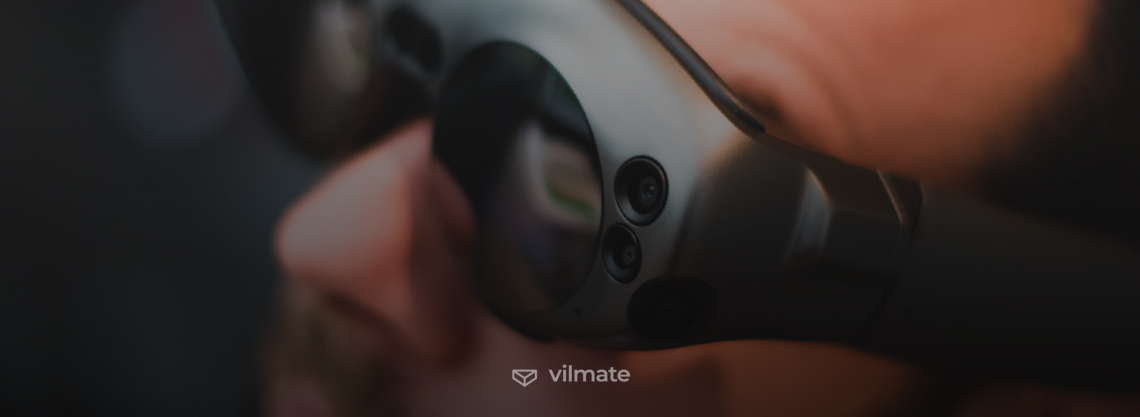
© 2020, Vilmate LLC




